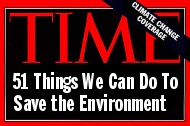| As we say on the final page of our POLAR-PALOOZA cards, there are many things anyone concerned about the adverse effects of climate change can do. Some are individual or can be done by families. Some are school-, university- or city-wide. Others are national and require changes in public policy. Here are a small sampling of the many lists of suggestions: we hope you will review and decide to implement some for yourself. Or think of new ideas and share them with others. |
 The Federal Environmental Protection Agency (EPA) has developed practical suggestions for HOME, SCHOOL, on the ROAD, and in the OFFICE. The Federal Environmental Protection Agency (EPA) has developed practical suggestions for HOME, SCHOOL, on the ROAD, and in the OFFICE.An Example: "Change 5 lights - Change a light, and you help change the world. Replace the conventional bulbs in your 5 most frequently used light fixtures with bulbs that have the ENERGY STAR and you will help the environment while saving money on energy bills. If every household in the U.S. took this one simple action we would prevent greenhouse gases equivalent to the emissions from nearly 10 million cars." http://www.epa.gov/climatechange/wycd/home.html An Example: "High school students check your school's climate impact - High school students can investigate the link between everyday actions at their high school, greenhouse gas emissions and climate change. Using EPA's Climate CHange Emission Calculator Kit (Climate CHECK) students can learn about climate change, estimate their school's greenhouse gas emissions and conceptualize ways to mitigate their school's climate impact. Students gain detailed understandings of climate-change drivers, impacts, and science; produce an emission inventory and action plan; and can even submit the results of their emission inventory to their school district. You can also use Portfolio Manager to compare the energy use of your school with other schools nationwide, and earn the ENERGY STAR for your school if it qualifies as a top performer." http://www.epa.gov/climatechange/wycd/school.html An Example: "Drive smart - Many factors affect the fuel economy of your car. To improve fuel economy and reduce greenhouse gas emissions, go easy on the brakes and gas pedal, avoid hard accelerations, reduce time spent idling and unload unnecessary items in your trunk to reduce weight. If you have a removable roof rack and you are not using it, take it off to improve your fuel economy by as much as 5 percent. Use overdrive and cruise control on your car if you have those features." http://www.epa.gov/climatechange/wycd/road.html An Example: "Manage office equipment energy use better - Office equipment and electronics use energy even when idle or on stand-by. To save energy and reduce greenhouse gas emissions at work, always activate the power management features on your computer and monitor, unplug laptop power cords when not in use and turn off equipment and lights at the end of the day. Consider using a power strip that can be turned off when you're done using your computers, printers, wireless routers and other electronics." http://www.epa.gov/climatechange/wycd/office.html |
 PARADE Magazine is one of the most widely distributed Sunday supplements, appearing in newspapers nation-wide. PARADE Magazine is one of the most widely distributed Sunday supplements, appearing in newspapers nation-wide.Their 2006 article was entitled, "You Can Make a Difference - 25 Ways To Help Curb Climate Change." PARADE wrote, "They may seem insignificant, but the choices we make every day have an impact on climate change. Luckily, there are simple things each of us can do immediately to reduce our contribution to global warming. The PARADE website suggests 25 simple opportunities to make a difference." Three of their simple suggestions:
|
 TIME Magazine has reported extensively on climate change, and as part of their special coverage of global warming, provided "51 Things We Can Do To Save the Environment" TIME Magazine has reported extensively on climate change, and as part of their special coverage of global warming, provided "51 Things We Can Do To Save the Environment""Can one person slow global warming? Actually, yes. You - along with scientists, businesses and governments-can create paths to cut carbon emissions. Here is our guide to some of the planet's best ideas." An example: "7. Hang Up a Clothes Line, by Bryan Walsh You could make your own clothes with needle and thread using 100% organic cotton sheared from sheep you raised on a Whole Foods diet, but the environmental quality of your wardrobe is ultimately determined by the way you wash it. A recent study by Cambridge University's Institute of Manufacturing found that 60% of the energy associated with a piece of clothing is spent in washing and drying it. Over its lifetime, a T shirt can send up to 9 lbs. of carbon dioxide into the air." |
 Founded in 1951, and with more than a million members, the Nature Conservancy calls itself, "the leading conservation organization working around the world to protect ecologically important lands and waters for nature and people." Founded in 1951, and with more than a million members, the Nature Conservancy calls itself, "the leading conservation organization working around the world to protect ecologically important lands and waters for nature and people."Writes Patrick Gonzalez, climate change scientist for The Nature Conservancy, "Trees store carbon and help slow the pace of climate change. What's a ton of carbon? A ton of carbon is released when you:
Each person can make a difference because one small positive act multiplied millions of times produces immense benefits." One of Patrick's tips: "Travel light. Walk or bike instead of driving a car. Cars and trucks run on fossil fuels, which release carbon dioxide into the atmosphere. In the United States, automobiles produce over 20 percent of total carbon emissions. Walk or bike and you'll save one pound of carbon for every mile you travel." |
 From the World Wildlife Fund, suggestions for individuals, families and students at school and college: From the World Wildlife Fund, suggestions for individuals, families and students at school and college:
|
 Interested in going "carbon-neutral"? A pragmatic set of suggestions from Canadian environmentalist and broadcaster, David Suzuki: Interested in going "carbon-neutral"? A pragmatic set of suggestions from Canadian environmentalist and broadcaster, David Suzuki: |
 From Internet search giant, Yahoo, an interactive website that invites you to select actions and immediately see what they translate into as savings of CO2 emissions. From Internet search giant, Yahoo, an interactive website that invites you to select actions and immediately see what they translate into as savings of CO2 emissions.http://green.yahoo.com/pledge/create |
 And speaking of search engines, Google and other computer companies are members of the Climate Savers Computing Initiative. To find our how to save energy while online, visit: And speaking of search engines, Google and other computer companies are members of the Climate Savers Computing Initiative. To find our how to save energy while online, visit: |
 From Google, a handy Halloween pull-together of simple but powerful "tricks", with links to find out more. These "treats" are always in season. From Google, a handy Halloween pull-together of simple but powerful "tricks", with links to find out more. These "treats" are always in season.http://www.google.com/hauntedhouse08/tips.html |
 Al Gore and the Intergovernmental Panel on Climate Change shared the Nobel Peace Prize for their work on communicating the causes and impacts of climate change. Here are suggestions from one of the companion websites to Gore's AN INCONVENIENT TRUTH movie: Minimize your own impact - The most important thing you can do to help fight climate change is call on your elected officials to enact policies that will help solve it. However, you can save money and reduce your own contribution to global warming by making climate-friendly choices each day. Here are a few simple tips for living a more climate-friendly life: At Home: Turn down the heat and air conditioning when you aren't home. Try using a programmable thermostat or setting your thermostat yourself to 68 degrees while you are awake and lower it to 60 degrees while you are asleep or away from home. In the summer, keep the thermostat at 78 degrees while you are at home, but give your air conditioning a rest when you are away. This will allow you to save about 10% a year on your home energy costs. If every house in America did this, our total greenhouse gas production would drop by about 35 million tons of CO2. This is about the same as taking 6 million cars off of the road. On the Go: Take public transportation. One of the best ways to reduce your impact on the climate is to take a public bus, subway or train instead of driving. Since you don't have to keep your eyes on the road, you can read, talk with friends or listen to music while you travel. If just 10% of US passenger car travel were instead on mass transit, we would save 75 million tons of CO2. Give public transit a try for one trip a week to start. You may be surprised by how convenient reducing greenhouse gas emissions can be. If your community doesn't have many public transportation options, ask for it! Go to a city council meeting or write your city officials and tell them that good public transportation options are important to you, and good for the community. At Work: Use the sleep settings and the power switch for computers and monitors. These common pieces of home and office equipment consume a lot of electricity. The single most powerful climate change tool on these machines is the OFF switch. Forget what you've heard about how powering up equipment repeatedly wears it out. That's old information, dating back decades. Equipment can be safely switched off and powered back on when it's needed again. Also, make sure the hibernation and sleep settings are enabled (download a handy free tool for PCs that makes the settings super easy or click here for instructions to do it yourself). |
| From Columbia University's Earth Institute and the Lamont-Doherty Earth Observatory: Understand Your Carbon Footprint Given all of the scientific evidence proving the human impact on the climate of our planet, one thing seems certain: climate change is real. Yet with such a daunting, global challenge, it may seem difficult to understand your individual role. One easy place to start is to learn about the magnitude of your impact on climate change due to the greenhouse gases produced from your everyday decisions. Each day, we all generate greenhouse gases from our homes (by using electricity and burning natural gas), and from our transportation choices (by driving our cars and flying on airplanes). While we contribute to greenhouse gases from many of our other decisions, most of these come from the ones we make from our homes and transportation. The amount of greenhouse gases a person (or a family, or a city, state or country) produces is sometimes called a "Carbon Footprint." This number is measured in tons of CO2 and allows us to compare our part in climate change with others and learn ways that we can reduce our individual impacts. There are many websites that will calculate your carbon footprint after you answer some basic questions. Before you start, you will need to have the following information ready (you might have to ask your parents to help):
One good Carbon Footprint Calculator has been created by the U.S. Environmental Protection Agency: This site will let your family explore ways that you can reduce your Carbon Footprint - and it even tells you how much your Footprint will shrink if you make simple changes! Other Carbon Footprint Calculators available online: |
|
Polar Palooza Home | About The Poles | About Polar Palooza | The Travelers Educator's Corner | Sites and Cities | The HDvCC | Media Palooza Supplies & Resources | Credits & Contacts | Site Search | Polar Palooza Blog  POLAR-PALOOZA and the materials on this website are based upon work supported by the National Science Foundation under Grant No. 0632262. Any opinions, findings and conclusions or recommendations expressed in this material are those of PASSPORT TO KNOWLEDGE/Geoff Haines-Stiles Productions, Inc., and do not necessarily reflect those of the National Science Foundation. |